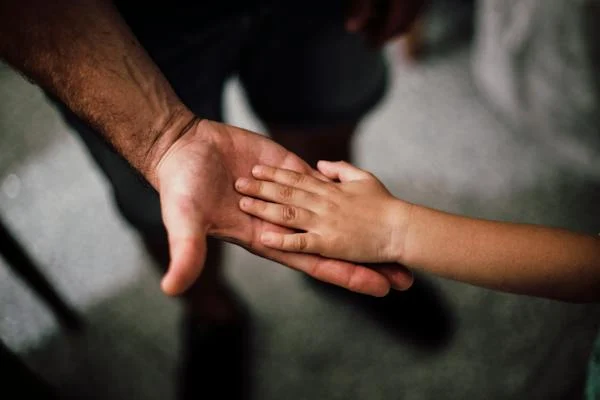Apr 10
8 min read
Staying Calm and Centered During COVID-19
We sat down with Crystal V. Pizarro, a life coach and licensed counselor, about how we can center ourselves in the maelstrom of COVID-19.

COVID-19, and the resulting stay-at-home and social distancing orders, are like nothing we’ve seen in our lifetimes. On top of that, kids are out of school. Parents are either out of work or trying to work from home with their spouses and kids present. Some people have gotten sick, and others have lost people to the coronavirus. Needless to say, we’re in a new normal people weren’t ready for—and certainly didn’t want.
We sat down with Crystal V. Pizarro, a life coach and licensed counselor, to talk about how we can center ourselves in the maelstrom of COVID-19. She also shares invaluable tips to help your children stay calm, along with meditation-focused exercises you can do together.
Q. What’s your overall vibe about how people are feeling about the current situation?
CP: In response to the current pandemic we’re facing, I’m seeing social media feeds flooded with people openly sharing their fears about having enough supplies, missing family members, worrying for their health and businesses, and regretting not being able to live life to the fullest before this transpired. The support they’re receiving is incredible. A multitude of people are stepping up and offering support, acts of kindness, encouragement, and physical and emotional resources. Additionally, social distancing, for many, has become a mirror into their marriages, parent-child relationships, as well as their relationship with themselves and their emotions. Many of us are spring cleaning our garages, but also old habits and perceptions to create a positive new normal for ourselves and our families.
Q. Obviously, self-care is really important during these times, especially when you’ve lost a job or are trying to care for other family members. What are some key ways we can take time out of our busy days to de-stress and get re-centered?
CP: Pause and relax the resistance. Your problem is already solved. You just haven’t reached that point in time yet. Our minds and bodies require stillness to de-stress. Centeredness is our truth; stillness allows us to return to it. This is especially important because our children are watching and automatically downloading our responses for their future use.
Set aside three minutes daily to create a space where you welcome everything. This is an opportunity to feel everything, knowing none of it defines you. These experiences, emotions and thoughts are passing through your awareness. Your body will show you what it’s shedding with your permission. Self-care is that permission.
Try this helpful exercise: Daily, take three minutes to empty your cup. This can include prayer, silence, breathing, listening to calming music, meditation, yoga, singing, art, or energy or bodywork, whatever works for you. I suggest a heart-centered technique, such as this one:
Close your eyes. Take a few deep breaths, imagining your breath is flowing in and out of your heart or chest area, breathing a little slower and deeper than usual.
1. Bring to your awareness an experience or person that represents pure joy, peace or happiness for you.
2. Walk yourself through the five senses to help you immerse yourself into that moment, to the point where you feel immense joy, peace or happiness.
3. Focus that intense joy, peace or happiness into your heart center.
4. Imagine a ball of healing light in your heart center.
5. Radiate that healing light throughout the rest of your body and out to others, trusting and knowing that the healing will go wherever it’s needed.
Q. Many kids are experiencing a lot of anxiety over the coronavirus and the big changes in their schedules. Others are missing sports games or plays or dance recitals. Still others may be profoundly sad about missing graduation. How can parents talk to their kids about this current situation and help ease their anxiety?
CP: Validate, validate, validate. Even greater than the fear of failure, can be the fear of regret. Talk less and listen more. A child’s worry is a window into their soul. Expressing a concern or a complaint is an indicator of an unmet need. According to Maslow’s Hierarchy of Needs, common needs include physiological needs, safety and security, love and belonging, self-esteem, and self-actualization. When you listen to your child, look for the unmet need and approach the conversation from this place: How else can this unmet need be fulfilled?
Consider this helpful tip: Before sitting down to talk to your child, check in to with your expectations. It may be helpful to redefine what a “good” or “productive” conversation looks like. In reality, a good or productive conversation is where your child is authentically his or herself and has connected with his/herself at a deeper level and/or has connected with you on a meaningful level.
Before meeting with some raw emotions that may come up on your child’s behalf, gift yourself with self-care time to empty your cup and release any agendas or expectations that you might have had. It’s common and understandable to want to remove our child’s pain. However, what serves them highest is to help them develop a healthy relationship with it.
When discussing the missing of important events, we want to ask our child about the meaning of those events. When something is important to us, it’s because we’re connecting “what it means” with a part of “who we are” such as: What does the dance recital mean to you? What does it mean if you attend? If you miss it? What does it mean about you if you attend? If you miss it?
Try this helpful exercise: On a lined sheet of paper, write all the variables (missing dance recital or graduation) of the situation. Next, on a piece of poster board, dry-eraser board or construction paper, create a Mind Map. A Mind Map is a powerful tool that combines high-level thinking with fun and creativity to organize thoughts and ideas with clarity. It involves a myriad of colors, shapes and designs.
Follow these instructions for your own Mind Map:
1. Create a circle in the middle and write a positive self-statement.
2. Draw five to 10 lines that come out like the sun’s rays.
3. Draw shapes at the end of these lines that will contain all of the constants within us. These can include creativity, intelligence, kindness and so on.
4. Ask: From this [constant], what positives can I create in this situation?
5. Draw lines and new shapes that contain these creators.
6. Repeat until all the constants have yielded creators.
7. When the Mind Map is complete, display your child’s creation and pick one creator to focus on at a time.
Tip: Have fun with this. Remember, we want to show our children problems are portals for creativity. Go ahead and break out the arts-and-crafts bin.
Q. What are some age-appropriate self-care techniques parents can pass onto their children?
CP: Follow the breadcrumbs. Do one thing you feel inspired to do (what your soul requires) at a time. You don’t need to know every step of your entire life. You just need to know the next one. What you feel called to do isn’t a chore, but an inspired action. This can include art, music, dance, read, nature or meditation. It can be trying something new. Since 98% of today’s thoughts are the same as yesterday’s, doing something new will allow more of your strengths and creativity to emerge; when you do things outside of your comfort zone, you think outside of it, too.
Additionally, it’s crucial to teach our children the art of grounding. A-ha moments and true inner peace can only exist in the present moment and grounding can return us to it. Many things aren’t a fear issue, rather a relationship issue. A wonderful and simple way to develop a healthy relationship with pain and fear is to associate pain or fear with a dose of self-love: “OK, it’s time to tune in and get grounded.”
Try this helpful exercise: This technique is simple yet powerful as a self-care technique to return us to the present moment.
1. Have your child envision the fear (or any uncomfortable emotion) as a cute puppy that just needs love.
2. Invite the puppy to sit right beside him/her and have your child say “I’m bigger than you and I’ll hold you. It’s OK, I’m here.”
3. Start the 5-4-3-2-1 grounding technique where your child names five things s/he can see, four things s/he can feel, three things s/he can hear, two things s/he can smell and one thing s/he can taste.
Q. Finally, do you have any tips for turning to optimism or gratitude?
CP: Both require seeing the whole situation with not just eyesight, but insight. Optimism and gratitude are already places inside of us. We just need to return to them. A great tip for returning to it is “widening and lengthening the lens” in any given situation. First, we want to widen the lens in the here and now and seeing with a fresh set of eyes ask: What else is possible? Where are the miracles? Where is the opportunity? How can I use this to connect with more layers of myself and to serve others? Next, we want to lengthen the lens ahead in time to see not just further into the situation, but beyond it.
If the level of the problem is 10 feet, go to 30 feet. Shift from being a problem-solver to a vision-holder. When you do, your mind becomes less of a registry of the past, and more of a map of your desired future. See this situation from an airplane view—the whole landscape—including where the problem no longer exists.
Focusing on the vision (which is vastly larger than the problem) will give you the inner fortitude to strengthen your mindset muscle and see the miracles that are already happening around and within you. If the problem is before you, know that the answer is already within you. Placing your hand on your heart*, closing your eyes, say to yourself, “The part of me that knows how to heal this, rise up. I’m listening.” *Placing your hand on your heart releases oxytocin, the hormone responsible for safety, trust and connection.
Try this helpful exercise:
1. Draw a 4 in. x 4 in. circle in the middle of a piece of paper and write the problem inside of it. 2. Draw three more circles around it and write the numbers 6, 12 and 24. These stand for six years, 12 years and 24 years from now.
3. Inside each of these three circles, describe the highest vision for your life across those years.
4. Write down phrases or draw images that encompass the five senses so you can really embody your highest vision.
5. Enter that part of the vision where the problem is resolved and think from it.
6. Now thinking from it, on a new piece of paper, jot down new insights and solutions for the current situation that rose up from within you. What ways can you be the reason someone is grateful today?

Crystal V. Pizarro, “The Life Coach for Moms,” helps moms all over the world press “reset” on their lives and course-correct back to their best selves. She holds a master’s degree in applied psychology and mental health counseling and is credentialed as a Licensed Professional Counselor, National Certified Counselor and Certified Holistic Life Coach with 14 years of expertise.
Connect with Crystal on her website: www.CrystalPizarro.com Join her Facebook page: Facebook.com/TheLifeCoachForMoms You can also take advantage of these FREE resources:
· FREE Live Q&A with Crystal on Fridays: Facebook.com/groups/MomsMasteringMindset



